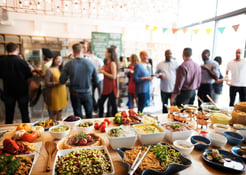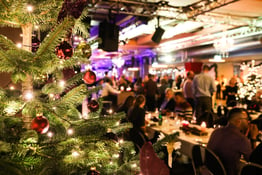With the rise of social media, food photography has become an indispensable part of restaurant marketing. But operating on thin margins, many operators question if hiring a professional to capture menu items is worth the investment.
The answer? It’s usually a “yes”, given that we eat with our eyes first, coupled with the fact that food is notoriously a tricky subject to photograph. Plus, social media is fast-paced. With visual online platforms, often you have just mere seconds to capture people’s attention as they scroll, making high-quality photos all the more valuable.
"The importance can’t be understated because when you think about all of the uses of photos, between delivery apps, your website, social media, and press, it really makes a huge impact,” says Elizabeth Tilton, founder and CEO of Oyster Sunday, a company that helps dozens of independent restaurants with their branding and marketing. “You also want your brand to be unified so that every single time someone comes to one of those platforms, there’s instantaneous recognition that it’s you.”
Working with a professional photographer can help synthesize your brand. And it’ll make it easier to ensure your food looks as good in photos as it does on the actual plates you produce.
“The lighting, styling, and angles are all important – just like people, food has its best angles,” says Audrey Knizek, food photographer and owner AM Knizek Photo.
Ready to make the jump? We break down what you need to know when hiring a food photographer, plus how to maximize your investment at the actual shoot.
Finding the Right Food Photographer for Your Business
Often the best place to start the search for a photographer is to simply ask fellow industry friends who they use. The majority of food photographers work with numerous clients, tweaking their style to fit each brand. You can also browse Instagram, and see what restaurants and/or food photographers have photos that resonate with you.
“As soon as you have a short list, it comes down to aesthetics and budget,” says Tilton.
Start by looking at each photographer’s portfolio to see if it matches the feel of your brand. Pay particular attention to lighting and editing styles, which can range from dark and moody to bright and airy to the currently trending colorful and contrasty, hot-flash style (see Bon Appetit). The next step is to reach out to get an idea of pricing. You’ll not only need to ask for hourly rates, but also inquire about if services include food styling, how long the shot list can be, estimated number of photos delivered, and image rights.
“Image rights – understanding how you’re able to use the photos and where – is something I find myself explaining a lot, and understandably so,” says Knizek. “You want to tell the photographer your intentions and what you have planned for the photos so that they can work that into the budget.”
Many photographers give digital and print rights, but it should never be assumed. Using photos in a print advertising campaign, for example, may require an extra usage fee. Always ask about the terms up front and make sure any contract you sign has them clearly written out.
Pricing: What to Budget and Expect
Pricing for food photography can range widely. Some photographers charge by the hour. Others offer full- and half-day rates, and some prefer to charge based off of the individual scope of the project. In general, however, expect to pay anywhere from $100 to $400 per hour.
“I’ve seen everything from $1,500 to $7,000 for a full-day shoot, and that’s why it comes down to your budget. But there are some remarkable photographers doing it for $150 an hour, and you can absolutely make it work as a small operator without going the most expensive route,” says Tilton.
Budgeting is always a challenge. But remember to keep the return on investment in mind, says Tilton. Photography can yield significant payoffs, especially if your website and delivery platforms are major traffic drivers for your business.
If you aren’t able to budget beyond a few hundred dollars, simply start small. Many photographers are open to shoots that entail capturing as little as three to five dishes.
“With a mini shoot, you can test your relationship with that photographer and make sure it’s the right fit,” says Knizek. “Then if you love how it went and the end results, you can use those photos while saving for a larger shoot in three to six months.”
Tips for Maximizing Your Investment and Shoot Time
You’ve chosen a photographer. And now you want to maximize your investment. Your first step? Create a shot list, an essential reference point for keeping the process organized and efficient. This is a detailed list of specific menu items you want captured, which may also include other photo requests, like dining room interiors and action shots in the kitchen. Its length will depend on the terms you’ve agreed to with your photographer.
“When it comes to prioritizing, start with things that are evergreen,” says Tilton. “That could include your interiors and exteriors, and then items that will be on the menu for a while.”
Identify your best-sellers, and aim to choose one or two dishes from each section of your menu. The goal is to get some variety that you can use for marketing collateral, while striving for quality over quantity.
“My biggest piece of advice is to slow down,” says Knizek. “I’ve had initial client calls where they think we’re going to shoot 50 dishes in a day. You’re spending all this money to get these dishes photographed. You want them to look beautiful, and that takes time.”
Once the shot list is set and shared, many photographers welcome you to send over a few quick photos of some of the dishes. This provides an idea of elements like dishware and composition, which allows photographers to think through gear and lighting and come prepared as possible. You also want to make staff aware of the photoshoot, and potentially even ask if they’re open to participating. “Any hands, or life, you can bring into the photos – like a bartender pouring the cocktail into the glass – makes [the photos] so much more exciting,” says Knizek.
On the day of, ask the photographer up front how much time they expect to need with each dish and communicate that with kitchen staff. “That way the food is as fresh as possible,” says Knizek. “I’ve had shoots where I get done setting up, and all of a sudden all the food is ready at once, and by the time I get to the last dish, it’s looking less than ideal.”
Once it’s time to plate, Knizek tells her clients to bump up the presentation, “but just one notch”. This might mean adding a few extra tomatoes to the salad, but not doubling the amount of goat cheese that goes with it. “You still want it to be authentic, and this way, if someone sees a dish on social media and comes in and orders it, it’s still a realistic representation,” says Knizek.
Developing an Ongoing Relationship with Your Photographer
Ideally the first shoot with your photographer won’t be your last. Developing a relationship with a photographer allows you to keep your social media and website fresh, while maintaining brand consistency. And if you’re able to plan ahead, often you can negotiate pricing at reduced rates.
“If I have the chance to sign a retainer with the client, I will absolutely give a discounted rate because that’s reliable business for me,” says Knizek.
When able, map out how many shoots you might need in a quarter or across the year, considering factors like seasonal menu changes, major events, and annually popular specials. Then, ask your photographer if they offer any package deals. Generally, your food photographer isn’t going to be the person capturing day-to-day Instagram stories, but they can supply you with new photos seasonally to add variety and keep your content accurate.
When to Use iPhone or Smartphone Photos
A shoot with a professional food photographer should leave you with a strong catalog of images. But rarely is it going to supply you with enough visuals to keep your social media accounts continuously updated. It’s OK to strategically cycle through the photos you have. But given the capabilities of smartphone cameras today, it’s generally a good idea to capture additional footage on your own, especially for features like Instagram stories, which can keep audiences engaged in between actual posts.
“See if you can identify someone on the team that's on the floor who already enjoys social media as a creative outlet,” says Tilton. “If you get the right person, you can really start to build a voice behind your [Instagram] stories.”
Have a staff member in mind? Tilton recommends staffing this person for every professional photography shoot, too. This way they can capture b-roll of the food prep already happening, and repurpose it for video reels on your social accounts. “Then you’re basically doubling the content you’re receiving,” says Tilton.
You can also tap into user-generated content. This involves using photos from people who come to your restaurant, take photos, and tag your brand or location on Instagram. “A lot of these images can be super beautiful, and with permission and giving them proper credit, this can be a third way for getting content for your feed,” says Tilton.
Grace Dickinson is a reporter at Back of House. Send tips or inquiries to grace@backofhouse.io.
[Photo courtesy AM Knizek Photo]





